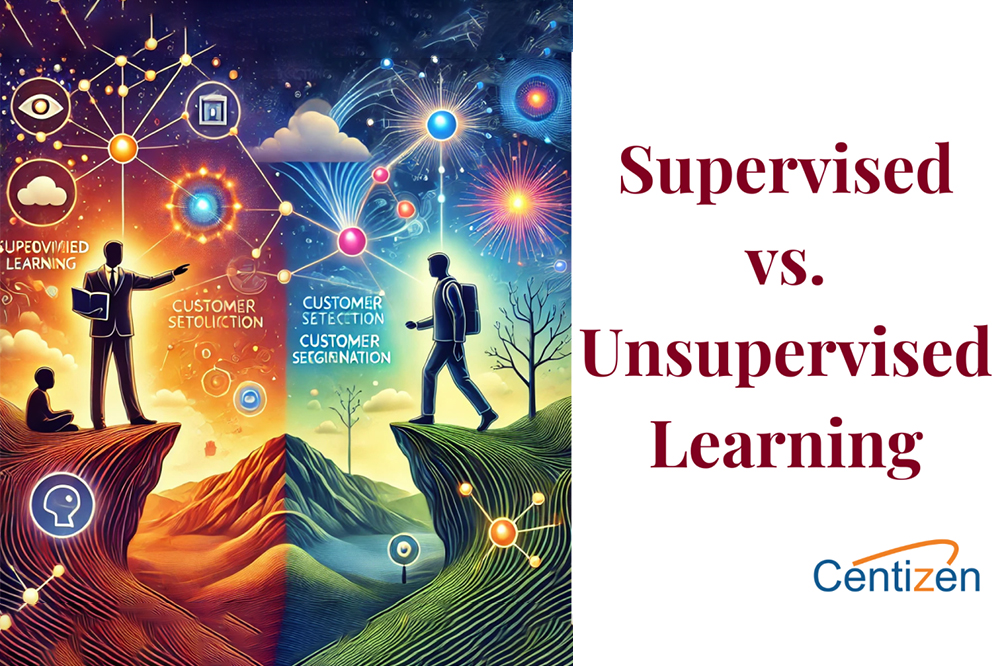Supervised vs. Unsupervised Learning

When it comes to training AI, there are two main approaches: Supervised and Unsupervised Learning. Each method has its unique process and use cases, but what makes them different? Let’s break it down into simple terms that anyone can understand.
1. What is supervised learning?
Supervised learning is like learning with a teacher. The AI is trained on a dataset that has clear labels, meaning it knows the “right answers” as it learns.
How it works:
- The dataset contains inputs and corresponding outputs.Example: A dataset of houses with features (size, location) and their prices.
- The AI learns the relationship between inputs and outputs.
- It uses this knowledge to make predictions on new, unseen data.
Example applications:
- Predicting house prices based on features.
- Classifying emails as spam or not spam.
- Recognizing objects in images.
2. What is unsupervised learning?
Unsupervised learning is like exploring without a guide. The AI is given data without any labels and is tasked with finding patterns or groupings on its own.
How it works:
- The dataset has inputs but no predefined outputs.Example: A dataset of customer purchase histories.
- The AI identifies similarities and organizes the data into clusters or patterns.
Example applications:
- Grouping customers into segments based on buying behavior.
- Detecting anomalies in network security.
- Discovering hidden patterns in large datasets.
3. Key differences between supervised and unsupervised learning
Feature: Labeled data
- Supervised learning: Requires labeled data.
- Unsupervised learning: Works with unlabeled data.
Feature: Goal
- Supervised learning: Predict outcomes.
- Unsupervised learning: Find hidden patterns or groupings.
Feature: Applications
- Supervised learning: Used for classification and regression tasks.
- Unsupervised learning: Used for clustering and anomaly detection.
Feature: Example
- Supervised learning: Predicting house prices based on labeled data.
- Unsupervised learning: Grouping customers into segments based on their purchase history.
4. Real-world examples
Supervised learning
- A healthcare AI predicts whether a tumor is malignant or benign based on labeled medical data.
Unsupervised learning
- A retail AI identifying customer segments for personalized marketing campaigns.
Conclusion
Supervised and unsupervised learning are two powerful techniques that help AI systems understand and process data. While one relies on labeled examples, the other explores patterns independently. Both play crucial roles in shaping the AI-driven world we live in today.
Our services:
- Staffing: Contract, contract-to-hire, direct hire, remote global hiring, SOW projects, and managed services.
- Remote hiring: Hire full-time IT professionals from our India-based talent network.
- Custom software development: Web/Mobile Development, UI/UX Design, QA & Automation, API Integration, DevOps, and Product Development.
Our product:
- ZenBasket: A customizable ecommerce platform.
- Zenyo payroll: Automated payroll processing for India.
- Zenyo workforce: Streamlined HR and productivity tools.
Centizen
A Leading IT Staffing, Custom Software and SaaS Product Development company founded in 2003. We offer a wide range of scalable, innovative IT Staffing and Software Development Solutions.
Contact Us
USA: +1 (971) 420-1700
Canada: +1 (971) 420-1700
India: +91 63807-80156
Email: contact@centizen.com
Our Services
Products
Contact Us
USA: +1 (971) 420-1700
Canada: +1 (971) 420-1700
India: +91 63807-80156
Email: contact@centizen.com






